怎么使用nodejs创建http服务器?下面本篇文章给大家介绍一下使用node创建一个简单的http服务器的方法,希望对大家有所帮助!

node.js基于node.js的Chrome引擎运行v8代码,因此我们可以摆脱浏览器环境,直接在控制台中运行js代码,比如下面这个js代码
console.log('hello world');控制台中直接使用hello world即可运行

node的内置模块node.js提供了基本的http服务的能力,基于http规范,我们可以使用CommonJS导入require模块进行使用http模块中有一个http函数能够让我们创建一个createServer服务器
其接收一个回调函数作为参数,这个回调函数接收两个参数 -- http和request。【相关教程推荐:nodejs视频教程】
response包括所有客户端请求的信息,比如request、请求头url、请求方式和请求体等header主要用于返回信息给客户端,封装了一些操作响应体相关的操作,比如response方法就可以让我们自定义返回体的头部信息和状态码当我们将响应体处理好了之后,调用response.writeHead方法就可以将响应体发送给客户端
使用response.end()函数只是帮我们创建了一个createServer对象,并没有让其开启监听,我们还需要调用Server对象的server方法才可以进行监听,真正作为一个服务器开始运行
listen方法的第一个参数是监听的端口号,第二个参数则是绑定的主机listen,第三个参数是一个回调函数,会被ip模块异步调用,当遇到错误的时候,就能够在这个回调函数的第一个参数中获取到抛出的异常 ,我们可以选择对异常进行处理,让我们的服务器更加健壮下面是使用http模块创建一个简单服务器的例子
const { createServer } = require('http');
const HOST = 'localhost';
const PORT = '8080';
const server = createServer((req, resp) => {
// the first param is status code it returns
// and the second param is response header info
resp.writeHead(200, { 'Content-Type': 'text/plain' });
console.log('server is working...');
// call end method to tell server that the request has been fulfilled
resp.end('hello nodejs http server');
});
server.listen(PORT, HOST, (error) => {
if (error) {
console.log('Something wrong: ', error);
return;
}
console.log(`server is listening on http://${HOST}:${PORT} ...`);
});可以直接尝试用http运行它,创造一个属于你的服务器!服务器运行后,浏览器访问http://localhost:8080即可访问到这个服务器
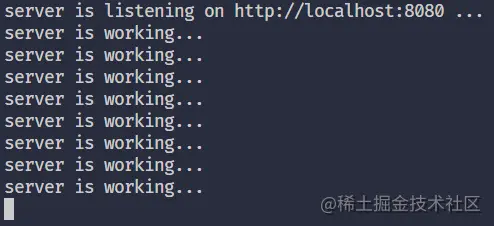
也可以使用node运行它,这样当我们的代码发生变化的时候就不需要手动终止程序再重新运行了
npm i -g nodemon
建议全局安装它,这样就可以直接使用,不需要通过nodemon去使用
使用也很简单,直接将npx nodemon命令改成node命令即可
nodemon http-server.js
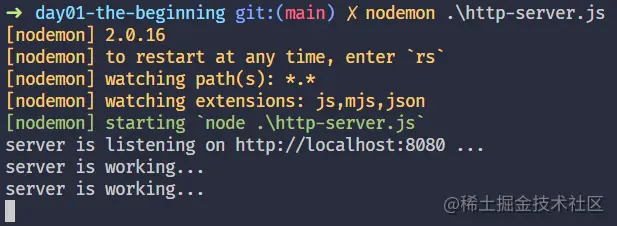
前面我们在使用nodemon以及createServer对象的时候,看不到任何的语法提示,必须随时跟着resp官方文档去边用边查,有点不方便
但是没关系,我们可以使用node的ts文件帮助我们提供语法提示功能,注意,我们不是使用.d.ts进行开发,只是使用它的语法提示功能而已
ts
npm init -y -- @types/node
pnpm i @types/node -D文件,将jsconfig.json排除在外,没必要对其进行检查{ "compilerOptions": {
"checkJs": true
},
"exclude": ["node_modules", "**/node_modules/*"]
}不知道你是否有发现上面的代码其实是有一处错误的呢?node_modules能够帮助我们检查类型错误问题,可以根据需要选择是否开启
可以看到,开启检查后立马就给我们提示了参数类型不匹配的问题
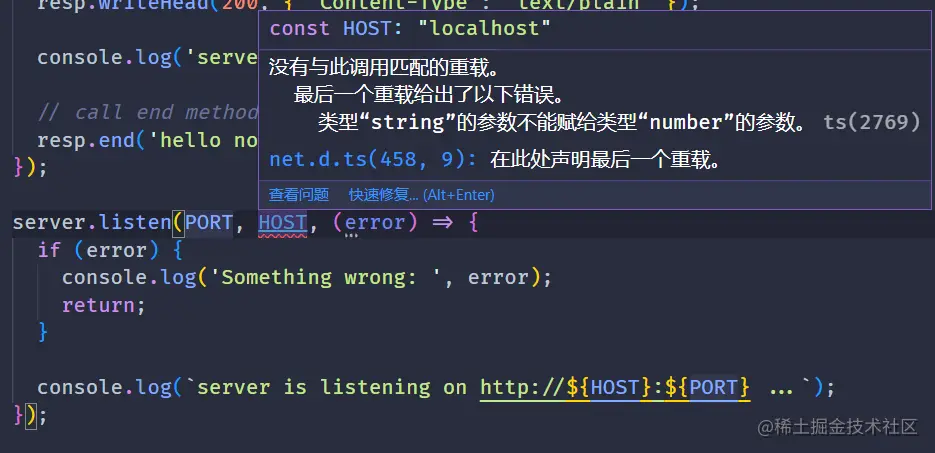
这时候将鼠标悬浮在checkJs方法上,就能够看到该方法的签名
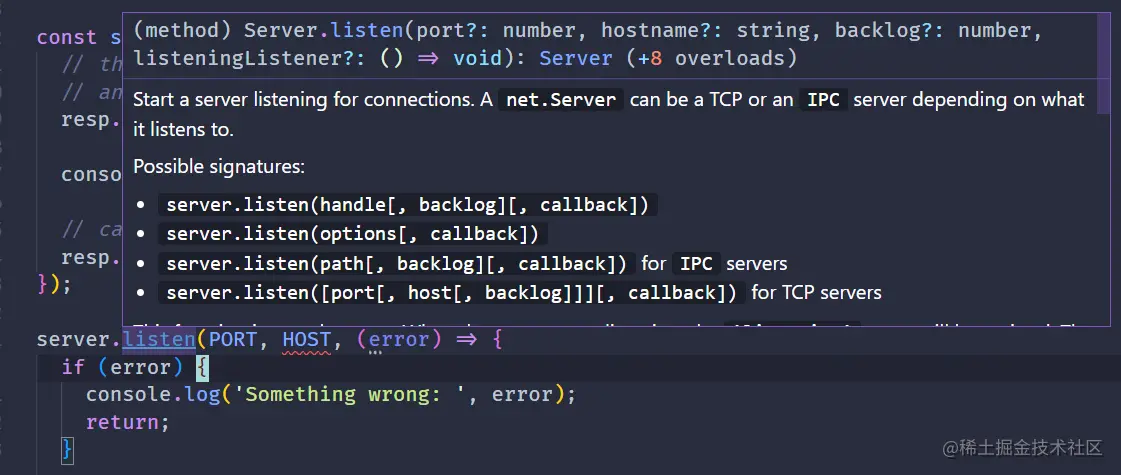
可以看到,原来listen参数需要是port类型,但是我们定义的时候是number类型,所以没匹配上,将其修改为string的number即可
而且可以直接查看到相关8080的文档,不需要打开api官方的文档找半天去查看了
前面我们的简单node中只返回了一句话,那么是否能够返回多句话呢?
这就要用到http server对象的resp方法了,write只能够返回一次内容,而是用end方法,我们可以多次写入内容到响应体中,最后只用调用一次write,并且不传递任何参数,只让他完成发送响应体的功能
const { createServer } = require("http");
const HOST = "localhost";
const PORT = 8080;
const server = createServer((req, resp) => {
resp.writeHead(200, { "Content-Type": "text/plain" });
console.log("server is working...");
// write some lorem sentences
resp.write("Lorem ipsum dolor sit amet consectetur adipisicing elit.\n");
resp.write("Omnis eligendi aperiam delectus?\n");
resp.write("Aut, quam quo!\n");
resp.end();
});
server.listen(PORT, HOST, (error) => {
if (error) {
console.log("Something wrong: ", error);
return;
}
console.log(`server is listening on http://${HOST}:${PORT} ...`);
});这次我们写入了三句话,现在的效果就变成这样啦

我们不仅可以返回字符串给浏览器,还可以直接读取end文件的内容并将其作为结果返回给浏览器
这就需要用到另一个html的内置模块 -- Node.js,该模块提供了文件操作的功能
使用fs可以异步进行读取文件的操作,但是它不会返回fs.readFile对象,因此我们需要传入回调去处理读取到文件后的操作
还可以使用promise进行同步阻塞读取文件,这里我们选择异步读取
const { createServer } = require("http");
const fs = require("fs");
const HOST = "localhost";
const PORT = 8080;const server = createServer((req, resp) => {
// change the MIME type from text/plain to text/html
resp.writeHead(200, { "Content-Type": "text/html" });
// read the html file content
fs.readFile("index.html", (err, data) => {
if (err) {
console.error(
"an error occurred while reading the html file content: ",
err
); throw err;
}
console.log("operation success!");
resp.write(data);
resp.end();
});
});
server.listen(PORT, HOST, (error) => {
if (error) {
console.log("Something wrong: ", error);
return;
}
console.log(`server is listening on http://${HOST}:${PORT} ...`);
});现在的结果就像下面这样:

成功将fs.readFileSync返回注意:这里需要将响应头的html改为**Content-Type**,告知浏览器我们返回的是**text/html**文件的内容,如果仍然以**html**返回的话,浏览器不会对返回的内容进行解析,即便它是符合**text/plain**语法的也不会解析,就像下面这样:
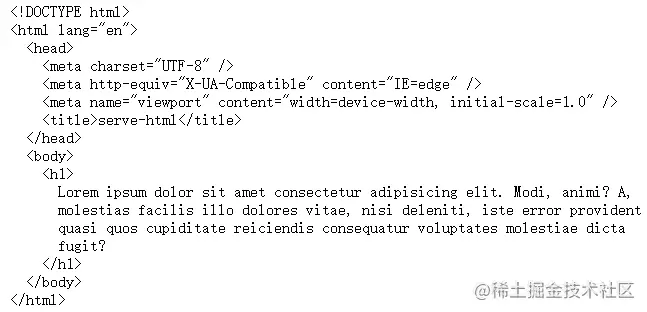
当我们需要编写一个后端服务器,只负责返回接口数据的时候,就需要返回**html**格式的内容了,相信聪明的你也知道该怎么处理了:
json类型设置为MIME
application/json的时候传入的是resp.write字符串,可以使用json处理对象后返回const { createServer } = require("http");
const HOST = "localhost";
const PORT = 8080;
const server = createServer((req, resp) => {
// change the MIME type to application/json
resp.writeHead(200, { "Content-Type": "application/json" });
// create a json data by using an object
const jsonDataObj = {
code: 0,
message: "success",
data: {
name: "plasticine",
age: 20,
hobby: "coding",
},
};
resp.write(JSON.stringify(jsonDataObj));
resp.end();
});
server.listen(PORT, HOST, (error) => {
if (error) {
console.log("Something wrong: ", error);
return;
}
console.log(`server is listening on http://${HOST}:${PORT} ...`);
});结果如下:

和之前返回JSON.stringify文件的思路类似,都是一个设置响应头html类型,读取文件,返回文件内容的过程
但是这次我们搞点不一样的
我们的思路是在服务器运行的时候生成一个MIME文件,并将它返回
还需要将pdf的类型改为MIME生成application/pdf文件需要用到一个库 -- pdf
pnpm i pdfkit
首先我们编写一个创建pdfkit文件的函数,因为创建pdf文件还需要进行一些写入操作,不确定什么时候会完成,但是我们的请求必须等到pdf文件创建完成后才能得到响应
所以我们需要将它变成异步进行的,返回一个pdf
/**
* @description 创建 pdf 文件
*/const createPdf = () => {
return new Promise((resolve, reject) => {
if (!fs.existsSync("example.pdf")) {
// create a PDFDocument object
const doc = new PDFDocument();
// create write stream by piping the pdf content.
doc.pipe(fs.createWriteStream("example.pdf"));
// add some contents to pdf document
doc.fontSize(16).text("Hello PDF", 100, 100);
// complete the operation of generating PDF file.
doc.end();
}
resolve("success");
});
};这里使用到了管道操作,将promise对象的内容通过管道传到新创建的写入流中,当完成操作后我们就通过PDFDocument告知外界已经创建好resovle文件了
然后在服务端代码中调用
const server = createServer(async (req, resp) => {
// change the MIME type to application/pdf
resp.writeHead(200, { "Content-Type": "application/pdf" });
// create pdf file
await createPdf();
// read created pdf file
fs.readFile("example.pdf", (err, data) => {
if (err) {
console.error(
"an error occurred while reading the pdf file content: ",
err
);
throw err;
}
console.log("operation success!");
resp.end(data);
});
});
server.listen(PORT, HOST, (error) => {
if (error) {
console.log("Something wrong: ", error);
return;
}
console.log(`server is listening on http://${HOST}:${PORT} ...`);
});现在浏览器就可以读取到创建的pdf文件了
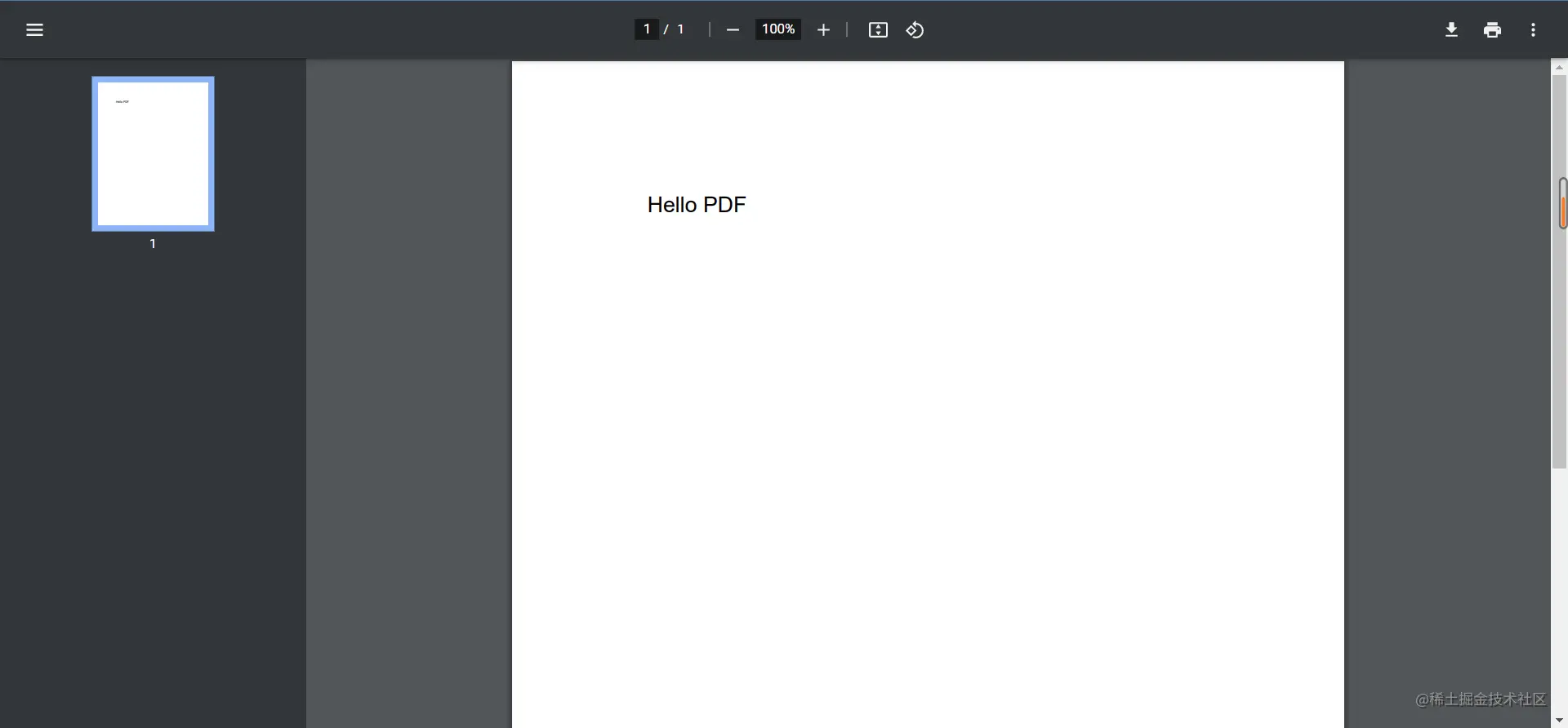
思路依然是一样的,读取一个音频文件,然后通过管道将它送到pdf对象中再返回即可
const { createServer } = require("http");
const { stat, createReadStream } = require("fs");
const HOST = "localhost";
const PORT = 8080;
const server = createServer((req, resp) => {
// change the MIME type to audio/mpe
resp.writeHead(200, { "Content-Type": "audio/mp3" });
const mp3FileName = "audio.mp3";
stat(mp3FileName, (err, stats) => {
if (stats.isFile()) {
const rs = createReadStream(mp3FileName);
// pipe the read stream to resp
rs.pipe(resp);
} else {
resp.end("mp3 file not exists");
}
});
});
server.listen(PORT, HOST, (error) => {
if (error) {
console.log("Something wrong: ", error);
return;
}
console.log(`server is listening on http://${HOST}:${PORT} ...`);
});效果如下

打开后就是一个播放音频的界面,这是resp提供的对音频文件的展示,并且打开控制台会发现有返回音频文件

注意:将音频文件流通过管道传到chrome后,不需要调用**resp**方法,因为这会关闭整个响应,导致音频文件无法获取


视频文件和音频文件的处理是一样的,只是**resp.end()**的类型要改成MIME,其他都一样
const { createServer } = require("http");
const { stat, createReadStream } = require("fs");
const HOST = "localhost";
const PORT = 8080;
const server = createServer((req, resp) => {
// change the MIME type to audio/mpe
resp.writeHead(200, { "Content-Type": "audio/mp4" });
const mp4FileName = "video.mp4";
stat(mp4FileName, (err, stats) => {
if (stats.isFile()) {
const rs = createReadStream(mp4FileName);
// pipe the read stream to resp
rs.pipe(resp);
} else {
resp.end("mp4 file not exists");
}
});
});
server.listen(PORT, HOST, (error) => {
if (error) {
console.log("Something wrong: ", error);
return;
}
console.log(`server is listening on http://${HOST}:${PORT} ...`);
});
我们学会了:
video/mp4创建一个Node服务器http加上类型提示js
html
JSON文件虽然内容简单,但还是希望你能跟着动手敲一敲,不要以为简单就看看就算了,看了不代表会了,真正动手实现过后才会找到自己的问题
更多node相关知识,请访问:nodejs 教程!
以上就是浅析用Node创建一个简单的HTTP服务器的详细内容,更多请关注php中文网其它相关文章!

每个人都需要一台速度更快、更稳定的 PC。随着时间的推移,垃圾文件、旧注册表数据和不必要的后台进程会占用资源并降低性能。幸运的是,许多工具可以让 Windows 保持平稳运行。

Copyright 2014-2025 https://www.php.cn/ All Rights Reserved | php.cn | 湘ICP备2023035733号